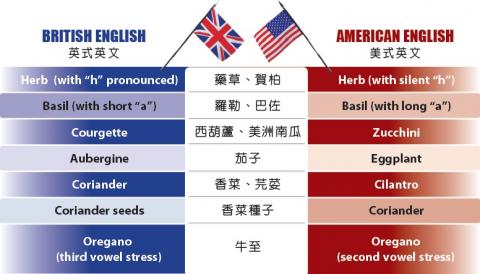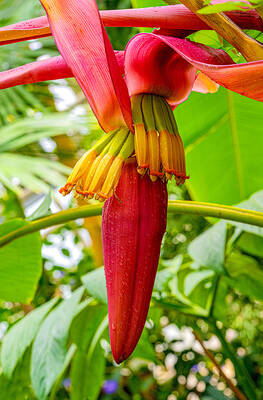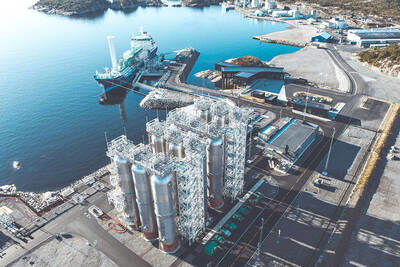Herb and Basil are men’s names. Herb is also the name of a herbaceous plant; basil is a kind of herb. In British English, the men’s names and the herb are pronounced identically. In American English, “herb” for the plant drops the “h”; “basil” as an herb has a long “a,” so it is pronounced differently from the name.
The word “herb” comes from the Old French erbe, which became herbe in Modern French, gaining the “h” from the Latin original (herba) but not the “h” sound. British English followed suit until the 19th century, when the “h” sound started to be pronounced; American English inherited the French pronunciation and stuck with it.
Sticking with words inherited from the French, courgette (meaning “small gourd” in French), aubergine and coriander are the British English alternatives for zucchini (from Italian), eggplant (from its appearance) and cilantro (from Spanish), respectively, used in American English. In the US, cilantro is the name for the leaves and stem of the plant; coriander the name for its dried seeds. In British English, the latter are called coriander seeds, to differentiate them from the leaves.

In addition to the different pronunciation of the herb basil between British and American English, the two have different stress for the word “oregano.” In British English, “oregano” has the stress on the third vowel; in US English, the stress is on the second.
(Paul Cooper, Taipei Times)
Herb(賀柏)和Basil(巴佐)是男性的名字,herb(藥草)亦泛指某一類草本植物,Basil(羅勒)則是其中一種。在英式英文中,herb這個字當人名和藥草時的發音相同。在美式英文中,herb當藥草時字母「h」的音會省略;basil這個字當羅勒時字母「a」的音會拉長,跟名字唸法有所差異。
英文字「herb」源自於古代法文的「erbe」,這個字已演變為現代法文的「herbe」,雖然拼字上受其拉丁字源(herba)影響多了一個「h」,不過並不發音。英式英文便依循此規,直到十九世紀才開始發出「h」音;美式英文承繼原來的法式唸法,並堅持到今日。
在英式英文中堅持法式傳統的字還有︰courgette(法文的小葫蘆)、aubergine(茄子)、coriander(香菜、芫荽)。這些字在美式英文中分別稱為︰zucchini(美洲南瓜,源自義大利文)、eggplant(茄子,源自外形)、cilantro(香菜、芫荽,源自西班牙文)。在美國,cilantro是指香菜的葉與莖,coriander是指其乾燥的種子。在英國,香菜種子叫coriander seeds以和香菜葉有所區隔。
除了藥草/羅勒在英式和美式英文中發音不同,另一種草本植物oregano(牛至)在兩者中重音亦不同︰「oregano」一字以英式英文發音,重音是在第三個母音;若以美式英文發音,其重音則是在第二個母音。
(台北時報張聖恩譯)

Have you ever wondered why “Manila envelopes” carry that name? The answer lies in a plant native to the Philippines. Though a fruit-producing plant, abaca is most valued for its leaf stalks, which are __1__ to extract fibers known as “Manila hemp.” These fibers are known for their strength and resistance to saltwater. Because of its __2__ in sea environments, Manila hemp has long been used to make Manila rope, a staple in the sailing and maritime industries for centuries. It withstands harsh ocean conditions without its flexibility being __3__. Manila rope doesn’t break down easily when exposed to

A: In addition to boyband Energy’s concerts, Taiwan’s first major male dance revue has attracted attention. B: Several South Korean male dance revues and Australia’s Thunder from Down Under often tour Taiwan. Now Taiwan’s first all-male revue has finally appeared. A: According to the Liberty Times, Muscle High: A Male Dance Revue from Taiwan, featuring 13 hunks, opened last month and will run until Sept. 14. B: The rise of “hunk fever” in recent years has even caused a trend of working out in Asia. A: Let’s go to the Taipei Music Center’s Sub Livehouse for the show. A:

A: Any fun events happening this weekend? B: Boyband Energy’s concerts and Taiwan’s first major male dance revue have both sparked anticipation recently. A: Energy staged a comeback last year — 15 years after they disbanded — and they’re now more popular than ever. B: Their megahit “Friday Night” even won Song of the Year at the Golden Melody Awards. A: To pay tribute to the Queen of Pop Madonna, they added her choreography of 16 continuous jump squats to their music video, prompting a “16-squat challenge” that went viral across Taiwan. Do you wanna try it out? A:

In a major step to combat carbon emissions, Norway’s pioneering “Northern Lights project” is set to expand its carbon capture and storage (CCS) capabilities. Backed by energy giants and the Norwegian government, this collaborative project is working to increase its annual carbon storage capacity from 1.5 million to over five million tons. Northern Lights focuses on capturing CO2 emissions from industrial sources across Europe and securely storing them underground. Captured CO2 will be liquefied and transported by ship to the storage facility located off the coast of Norway. It will be injected through pipes into geological formations about 2,600m below the